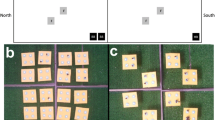Abstract
Small groups of honeybees (five to nine individuals) were trained to forage at feeders 150 m, 300 m and 800 m from an observation hive. Their behaviour in the hive and at the feeder was recorded by observers that maintained continuous radio contact with one another. At low concentrations of sugar in the feeder (0.5 mol l−1) foragers do not dance in the hives, their flights to the feeder are often undertaken alone, they land immediately after arrival at the site and no recruits from the hive landed on the feeder during 30 h of observation. Raising the concentration of sugar in the feeder to 2 mol l−1 leads to vigorous dancing by the foragers and the gradual (over 10–15 min) synchronisation of their flights so that they arrive in groups of up to five bees at the feeder and undertake circular "buzzing" flights before landing. Such behaviour of the foragers is associated with the appearance of recruits which were never seen to fly around the feeder and land alone or before the foragers. Recruits typically circle the feeder together with foragers and land with them or continue their circling flights to land about 10 s later. While circling the feeder recruits, but not foragers, will fly after a moving lure if the presentation of the lure is accompanied by the release of geraniol scent. We propose that recruits that have witnessed a waggle dance are unlikely to find a non-scented feeder unless the foragers continue their flights to that feeder and provide supplementary visual and/or olfactory cues, at least in the vicinity of the feeder. We propose that the synchronisation of the flights of foragers and their behaviour at the feeding site is a strategy designed to overcome a navigational gap in the recruiting process in which the dance can indicate the general area of a food source but not the precise position of a highly localised site.





Similar content being viewed by others
References
Ambrose JT (1976) Swarms in transit. Bee World 57:101–109
Dyer FC (2002) The biology of the dance language. Annu Rev Entomol 47:917–949
Esch H, Zhang S, Srinivasan M, Tautz J (2001) Honeybee dances communicate distance by optic flow. Nature 411:581–583
Fernandez PC, Gil M, Farina WM (2003) The effect of the reward rate on the number of honeybees. (Apis mellifer L.) arriving at a feeding place: recruiting mechanisms and temporal distribution of arrivals. Behav Ecol Sociobiol 2003 (in press)
Frisch K von (1923) Über die Sprache der Bienen. Zool Jhrb Allg Zool Physiol 40:1-123
Frisch K von (1965) Tanzsprache und Orientierung der Bienen. Springer, Berlin Heidelberg New York
Gries M, Koeniger N (1996) Straight forward to the queen: pursuing honeybee drones (Apis mellifera L.) adjust their body axis to the direction of the queen. J Comp Physiol A 179:539–544
Lindauer M (1955) Schwarmbienen auf Wohnungsuche. Z Vergl Physiol 37:263–324
Maeterlinck M (1901) Das Leben der Bienen. Diederichs, Leipzig
Seeley TD, Morse RA, Visscher PK (1979) The natural history of the flight of honey bee swarms. Psyche 86:103–113
Tautz J, Rohrseitz K, Sandeman DC (1996) One-strided waggle dance in bees. Nature 382:32
Wehner R, Stulzer W, Obrist M (1985) The bee-dance controversy revisited. Experientia 41:1223
Wenner AM, Wells PH (1990) Anatomy of a controversy. Columbia University Press, New York
Wenner AM, Meade DE, Friesen LJ (1991) Recruitment, search behavior and flight ranges of honey bees. Am Zool 31:768–782
Acknowledgements
This work was financially supported by the Deutsche Forschungsgemeinschaft (SFBs 251, 554 and Graduiertenkolleg "Behavior of Arthropods"). We thank M. Gossner and S. Schürkens for careful support in the field work and B. Bujok for figures. H. Vogt and Ch. Pirk helped with the statistics. The experiments comply with the Principles of animal care, publication No.86-23, revised 1985 of the National Institute of Health and also with the current laws of the Federal Republic of Germany.
Author information
Authors and Affiliations
Corresponding author
Rights and permissions
About this article
Cite this article
Tautz, J., Sandeman, D.C. Recruitment of honeybees to non-scented food sources. J Comp Physiol A 189, 293–300 (2003). https://doi.org/10.1007/s00359-003-0402-6
Received:
Revised:
Accepted:
Published:
Issue Date:
DOI: https://doi.org/10.1007/s00359-003-0402-6




